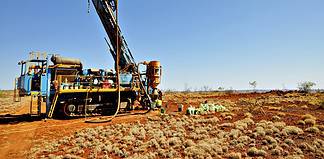WITH nickel recently posting its best quarter in almost a decade and the recent Paydirt 2019 Australian Nickel Conference in Perth, it’s no surprise that the future of the metal has been the talk of the town.
The London Metal Exchange (LME) nickel price hit $US18,620/t early last month, having opened the year at $US10,435/t.
This has been partially fuelled by concerns around the impact of Indonesia’s decision to bring forward a ban on exports of raw nickel ore by two years.
The ban will take effect from January 1, removing an estimated 350,000t out of the global sea trade.
Another geopolitical wobble impacting prices was the Government of Bangsamoro Autonomous Region in Muslim Mindanao (BARMM), an autonomous region within the southern Philippines, suspending operations of all four mining companies in its jurisdiction, on environmental grounds.
The price also benefited from falling LME and Shanghai Futures Exchange (SHFE) warehouse stocks and the metals ability to sidestep broader tensions and market jitters around the length and impact of the ongoing China-US trade tensions.
Overall, the resurgent nickel price has been a welcome boost for the base metal and has prompted some Australian producers in 2019 to investigate new exploration, mining and production opportunities.
WA Nickel
The geopolitical shifts and subsequent price rise have been a driving force for the West Australian nickel sector’s recovery.
Independence Group and Western Areas have enjoyed strong investor support on the back on nickel’s role in the electric vehicles and BHP (who tried to sell off its Nickel West division a few years ago) has done a complete 360 turn – with major expansions planned and a nickel sulphate production facility at its Kwinana site now operational.
Mincor Resources and Panoramic Resources are reviving mothballed operations and Black Mountain Mining, Poseidon Nickel and Ardea Resources have plans for production and nickel explorers like St George Ming and Legend Mining have had recent share price spikes.
The Nickel Institute’s director market development Richard Matheson said Australia’s nickel industry was in overall in a very good position.
“There is a real opportunity here to grow and defend market share both for existing applications and emerging new applications such as in new-era electric vehicle batteries, energy storage and even food and water applications,” Mr Matheson said.
“This opportunity is being driven by mega trends in population growth and the need for ‘more of everything’.
“So many parts of the world are urbanising quickly and massive migrations of people are elevating demand for more housing, more energy, more food and more clean water – all of which has to be delivered in sustainable ways.
“The scope of nickel’s properties is excellent for assisting these needs so the market for nickel can best be described as fantastic.”
Mr Matheson did warn the sector that it faced headwinds in reaching its true potential.
“The threats to nickel are very clear,” he said.
“There are perceptions of high cost, a lack of knowledge about the metal even though it is used everywhere.
“This is particularly true for new young engineers coming through industry who are not aware of nickel’s potential.
The Nickel Institute is attempting to circumvent this attitude and change perceptions around nickel in the head space of the younger generation who are designing and manufacturing new applications, like EVs.
“Nickel also faces competition and substitution from other materials as well as barriers to entry from any number of quarters,” Mr Matheson said.
“Yet nickel is buoyant, its annual output has grown roughly between 5% and 6% per year over the past decade. The opportunity is there.”
Bright outlook
Nickel has previously been dominated by the stainless steel sector, which comprises around 70pc of global nickel demand, but in recent years the emergence of the EV market has tipped the balance.
Analysts like UBS expect batteries in EVs to account for 12pc of global nickel demand by 2023, up from 3pc in 2018.
Nickel sulphate is essential to emerging new-era EV batteries as it is stable under high temperatures and resists over-charging – but battery materials buyers generally pay a premium.
There’s potential for EV nickel demand to rise above 20pc market share over the next decade along with a nickel floor price around the $US7-7.50-8.00/lb range – prompting a rush of negotiations over future offtake agreements.
The percentage customers pay compared to the actual nickel content of concentrates could also rise, potentially from the industry’s current average ‘payability’ of 70pc to more than 80pc for non-traditional concentrate buyers.
The expected EV demand forecasts can only be good news for WA’s nickel producers but the challenge remains whether or not they can keep up.








































